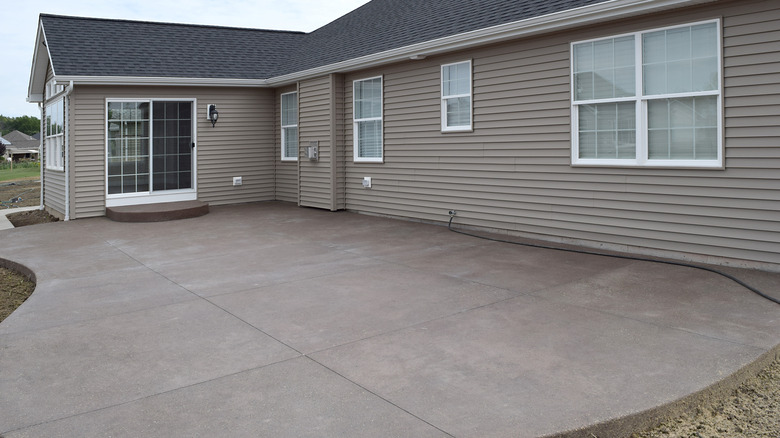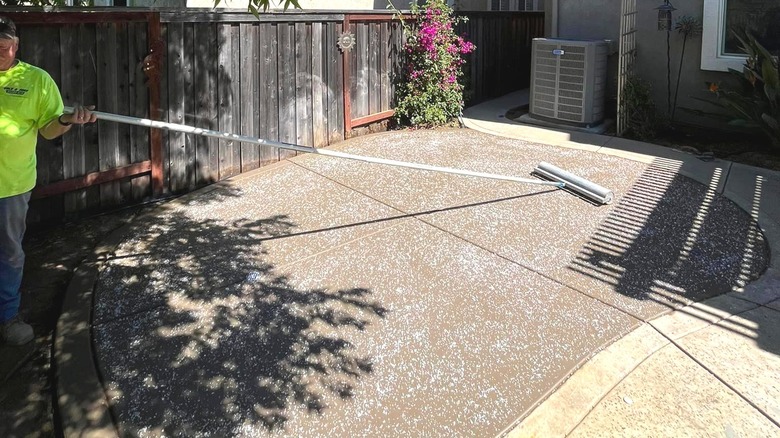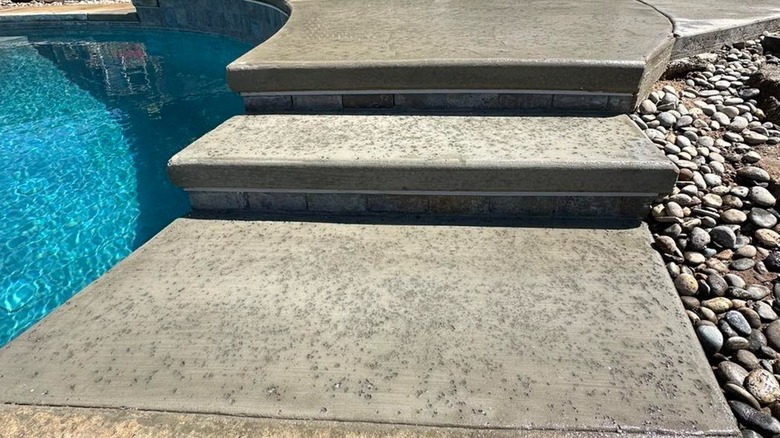The Pros And Cons To A Patio Salt Concrete Finish
Building a concrete patio might seem like a set-it-and-forget-it process, but there are a handful of decisions to be made when designing your dream patio. For one, it's important to know how to choose the best patio concrete finish to add instant charm to your backyard. Stamped concrete, stenciled concrete, and broom finish are a few popular options, but one more unique choice is the salt finish. To pull off this finish, the surface is either scattered with rock salt or pressed with a roller and left to settle after the concrete stain is applied. Sometimes a color can also be worked into the process to give the finish an even more dimensional look. Later, this rock salt is removed or washed away to reveal a unique dappled and textured surface. As with any finish, however, the salt finish has some pros and cons. While it offers good affordability, non-slip grip, and a natural aesthetic, it can be difficult to install correctly and keep clean.
A salt finish concrete patio can be a good choice for people who want to save money and enjoy a less common-looking result, but achieving the perfect salt finish can be a challenge for a few reasons. Even when it's all said and done, you may not like the naturally rustic results. Here's what you need to know about salted concrete to help you decide if this finish is right for your patio.
Salt finish is unique, affordable, and practical
The first big pro about salted concrete is that it's a relatively inexpensive finishing choice. At around $8 to $12 per square foot, according to Angi, salt-finished concrete is one of the most affordable materials to create a beautiful backyard patio, and can even be done as a DIY project. While it can help you save money, the salt finish doesn't skimp on style. A salted finish can be more aesthetically pleasing than other finishes, such as a broom streaking. Ronnie Natali, the owner and designer of custom building company, Buildometry, explains in an Instagram video, "I really like salted concrete because to me it's very timeless, but it takes on kind of a look of its own ... the little divots from the salt in the concrete eventually start accumulating [dirt] and they change colors and they get a little dirty... it starts looking more and more like a travertine or a stone."
Salted concrete also has some practical benefits. The little pores in the surface create some texture underfoot, making it a smart choice for poolsides, patios, and garden paths that tend to get wet from rain or splashing. The bumpy surface of salted concrete can also help to conceal any cracks or minor imperfections better than smooth or broom-finished concrete, and stands the test of time against ordinary wear and tear.
It can be hard to control the final results
Although the rock salt finish is easy to install, it can be difficult to achieve a smooth, even look depending on the size of your slab and other external factors. A rock salt finish is usually thrown on by hand, and because of this, the dappled and textured effect may be stronger in some areas and weaker in others, especially if it's hard to toss salt to the middle of a large slab. The timing of a rock salt finish is also crucial — if applied too late it won't sink enough to create texture, but if applied too early it will dissolve straightaway. After the concrete has set, it can be challenging to remove all of the rock salt from the crevices, and may require a few cleaning sessions with a broom and water hose. Failure to remove all of the salt could result in unwanted discoloration.
The pitted appearance of a salt finish is one of its attractive qualities, but dirt and water can collect in the pits, making it a little harder to sweep clean. People who prefer a tidy, smooth, and spotless patio may not enjoy the naturally "dirty" look of salted concrete. Salt finished concrete also isn't the most unique or customizable option out there; for those who want a truly curated outdoor space, there are plenty of creative design ideas for your concrete patio, such as stamped or stenciled concrete or concrete pavers.


